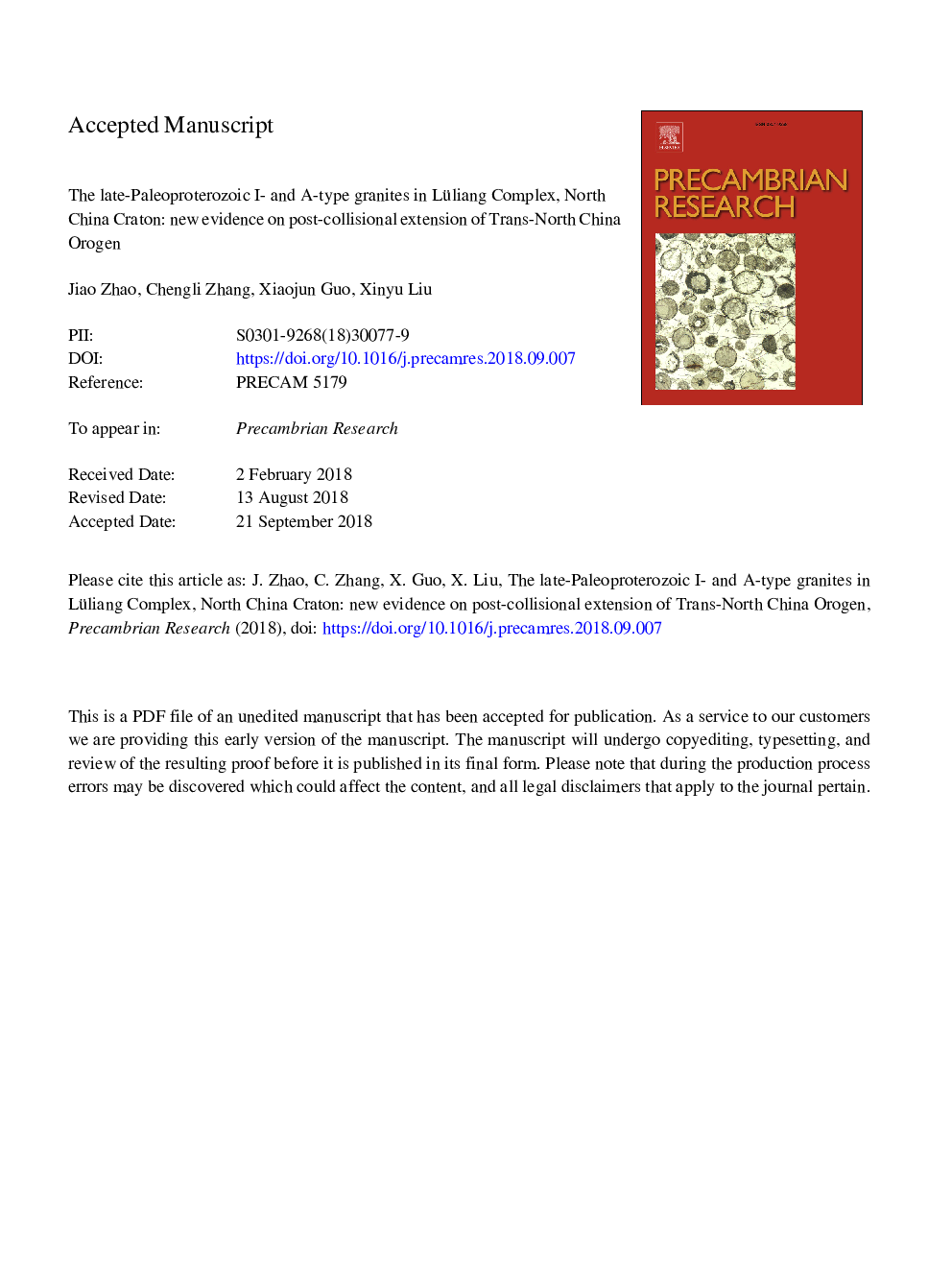| کد مقاله | کد نشریه | سال انتشار | مقاله انگلیسی | نسخه تمام متن |
|---|---|---|---|---|
| 11017675 | 1722596 | 2018 | 45 صفحه PDF | دانلود رایگان |
عنوان انگلیسی مقاله ISI
The late-Paleoproterozoic I- and A-type granites in Lüliang Complex, North China Craton: New evidence on post-collisional extension of Trans-North China Orogen
دانلود مقاله + سفارش ترجمه
دانلود مقاله ISI انگلیسی
رایگان برای ایرانیان
کلمات کلیدی
موضوعات مرتبط
مهندسی و علوم پایه
علوم زمین و سیارات
ژئوشیمی و پترولوژی
پیش نمایش صفحه اول مقاله

چکیده انگلیسی
The late-Paleoproterozoic granitoids from Lüliang Complex can provide pivotal constraints on the amalgamation process between Eastern and Western blocks of North China Craton along the Trans-North China Orogen. LA-ICP-MS zircon dating gives emplacement ages of 1854â¯Â±â¯20â¯Ma for the Huijiazhuang granite, 1830â¯Â±â¯21â¯Ma for the Xiyupi granite vein and 1760â¯Â±â¯20â¯Ma for the Dacaoping porphyritic granite, respectively. The Huijiazhuang granite and Xiyupi granite dyke have variable SiO2 (66.71-74.31â¯wt%), high K2O (5.09-6.35â¯wt%), low P2O5 (0.02-0.16â¯wt%), Al2O3 (13.92-15.31â¯wt%), right inclined REE patterns with medium negative Eu anomalies, enrichment in LILE, depletion in HFSE, especially Nb, Ta, consisting to high-K I-type granite in a post-collisional setting. The Sr/Y (7.36-59.95), εNd(t) (â5.7 to â4.1) with TDM (2381â¯Ma to 2570â¯Ma) from whole rock Sm-Nd isotope and εHf(t) (â9.6 to 2.3) with TCDM (2360â¯Ma to 3070â¯Ma) from zircon Lu-Hf isotope suggest that they are produced by partial melting of slightly thickened Neoarchean-Paleoproterozoic basement materials (including both meta-sedimentary and meta-igneous rocks). The Dacaoping porphyritic granites are characterized by high SiO2 (70.83-74.30â¯wt%), K2O (4.84-5.60â¯wt%), FeOT/(FeOTâ¯+â¯MgO) (0.86-0.92), “seagull-type” REE pattern with strong negative Eu anomaly (δEu=0.16-0.35) and higher 10000âGa/Al (2.99-3.36), HFSE (Zrâ¯+â¯Nbâ¯+â¯Ceâ¯+â¯Yâ¯=â¯378-583â¯ppm), showing an affinity of A2-type granite. They have low Sr/Y (1.17-8.62), εNd(t) (-6.1 to -6.4) with TDM (2690â¯Ma to 2776â¯Ma) from whole rock Sm-Nd isotope and εHf(t) (-7.9 to -5.2) with TCDM (2775-2938â¯Ma) from zircon Lu-Hf isotope, indicating a result from the melting of thinned Neoarchean calc-alkaline intermediate basement. Taking into account the temporal-spatial distributions of late-Paleoproterozoic rocks in the Trans-North China Orogen, it suggests a post-collisional extension occurred during 1.89-1.76â¯Ga and the crust is thinned visibly since 1.82â¯Ga.
ناشر
Database: Elsevier - ScienceDirect (ساینس دایرکت)
Journal: Precambrian Research - Volume 318, November 2018, Pages 70-88
Journal: Precambrian Research - Volume 318, November 2018, Pages 70-88
نویسندگان
Jiao Zhao, Chengli Zhang, Xiaojun Guo, Xinyu Liu,